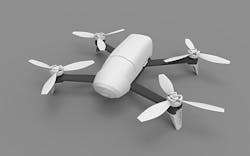Laser additive manufacturing helps produce unmanned aerial system
Reinforced composite materials used by CRP Technology (Modena, Italy) in the construction of on-car and wind tunnel parts and components for racing teams have taken laser additive manufacturing technology to new heights to produce parts for the Bebop 2 leisure drone.
Parrot (Paris, France), founded in 1994 by Henri Seydoux, launched the AR.Drone—a quadricopter piloted by Wi-Fi with a smartphone and equipped with an embedded camera—in 2010. Since then, the company has been leading the way in the civil drone industry with a range of drones and minidrones, and continues to guide the innovation with the state-of-the-art Bebop 2 that launched in 2015.
Powerful with impressive stability and maneuverability—even in extreme conditions—Bebop 2 offers easy-to-use piloting with no learning. Data collected by seven sensors are analyzed and merged, thanks to the impressive calculation capability of its onboard computer.
Bebop 2 integrates a specially designed, front-facing camera. A pilot can digitally change the angle of the camera 180° by sliding a finger on the screen of the piloting device. Digitally stabilized on three axes because of powerful algorithms, images are bright, perfectly stable, and without distortion, regardless of the drone movements.
Numerous systems reinforced the safety of the flights: the emergency cut-out feature of the engines and propellers in case of contact; limitation of the altitude and the flying perimeter; an automatic return-home feature; and an LED at the back of the machine to understand the direction of the flight while keeping the drone in sight.
Parrot developed Bebop 2 with the help of Windform GT material (FIGURE). The first Bebop 2 structure was built on injected parts made with polyamide-based, glass-reinforced composite material. The company moved to selective laser sintering (SLS) technology in collaboration with CRP Technology to optimize the structure performance without developing long lead time and high-cost injection tooling, and to accelerate iteration generation, improve manufacturing time, and facilitate production in series.
Parrot carried out an original development approach based on experimental diagnosis and an FE model aimed at improving the quality of the video during flight (which is usually altered by the vibrations of the drone) through the optimization of drone design. The structure has been mainly developed according to that target and by finding smart design to reduce weight.
Parrot validated that natural frequencies of parts manufactured with Windform GT material were similar to injected parts with polyamide-based, glass-reinforced composite material. The company was also able to evaluate toughness of the product structure.
Another advantage obtained with SLS and Windform GT material is small-batch production with acceptable mechanical properties to provide functional products to the team.
CRP Technology provided a fast iteration process, the best ratio between structural strength and weight, an acceptable and consistent result, and the opportunity to combine multiple functionalities from one unique part. They also provided fast response time to new requirements, very good cooperation with its engineers and CAD designers, and best output quality with a unique proprietary process.
For more information, please visit www.crp-group.com and www.parrot.com.

